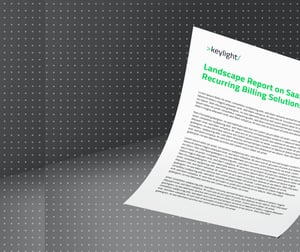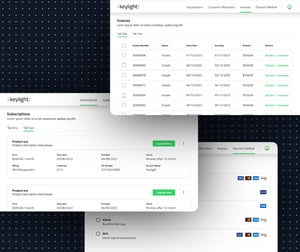Unique challenges & opportunities
Navigating the terrain of subscription finance as the CFO
Shouldering the financial responsibility for any company is a lot, but being the CFO of a subscription business has its own unique challenges and opportunities.
The pace of growth, the ongoing nature of sales, the ability to trade across sales tax jurisdictions and currencies, compliance and regulatory requirements, keeping track of revenue —all these things and more repeat on a persistent cycle. For CFOs, that means that in addition to the regular challenges of optimizing cash flow and undertaking financial planning for long-term growth, there's a lot to consider and a lot to stay on top of.
The beauty of all these elements is that they are exactly what makes subscription businesses such an exciting space to operate in, creating vast swathes of opportunity for success. However, to be a sustainably successful subscription business you have to accumulate volume, and you can't stay on top of all that manually as you scale. Subscription businesses need to be at the forefront of technology in order to run smoothly, and the good news is that the necessary tech solutions are out there to put CFOs minds at ease. You just need to know what to look for and why.
In this article we look at the top five concerns of CFOs in subscription businesses, and what you need to stay on top of them.
When looking for the right system for your business, the question you need to ask is not just what it does, but how does it meet your needs?
Sales tax compliance
The maze of sales tax in subscription models
Sales tax compliance in subscription business can be complicated for a couple of reasons.
Applied to goods and services, sales tax is typically a percentage of the purchase price and is added to the final cost of the product or service. However, in subscription businesses, the sale is repeated time and again at agreed intervals. That isn't an issue, except that the rate of tax is subject to changes, so it's important that business stays on top of the current rate and applies it accurately. Within that, your system also needs to align any changes with amendments to the subscription contract such as upgrades, downgrades, etc.
Furthermore, subscription businesses often trade across different countries and regions. Sales tax varies by location, with different countries, states and localities having their own rates. For example, in the USA, sales tax is not a federal tax, but a state and local tax. Again, where a product is sold and purchased needs to be considered by your system in order to calculate it correctly per sale.
The reason this can keep a CFO up at night is this kind of complexity can easily become difficult to track, trace and record accurately at scale, which could potentially lead to penalty fines.

How to solve the problem
A well-designed product catalog and customer account properties in the subscription billing system that differentiate product types and customer addresses, and connect with sales tax engines to accommodate and stay on top of all those complexities seamlessly, calculating the correct sales tax for invoices.
Payment processing
Accuracy and security in subscription payment processes
In any business, accurately processing and recording payments is a high priority. However, in a business model that's rooted in repeat payments, making sure that they are done and recorded correctly is especially important because a problem that goes unidentified can leak revenue and quickly become messy to resolve.
The challenges that can emerge in subscription billing and payments include:

Accurate revenue recognition
While payments might be taken from customers upfront, they cannot be fully recognized and distributed across the business until the service has been delivered. As there is often a delay between payment and product/service delivery, it can mean revenue needs to be recalculated due to customer change requests between payment and delivery, for example. That means you need a system that aligns all that information and can make the necessary accounting changes automatically.

Failed payments
Whether it's because payment information is out of date or because a payment provider's overzealous credit and security checks have declined a payment, being aware of, and quickly resolving, failed payments is important both for financial accuracy and customer retention. It's too easy to lose customers by "accident" because these things weren't handled quickly, efficiently and easily.

Payment security
Security of data, especially personal and financial information is one of the great challenges of the digital age. Businesses are responsible for looking after their customers, not only from a legal perspective, but also to protect their reputation and their customer relationships. The regulatory environment around subscription billing can be complex, differing across jurisdictions and changing constantly in everything from General Data Protection Regulation (GDPR) to the Payment Card Industry Data Security Standard (PCI DSS). Staying on top of this is vital to help protect against data breaches, compliance violations, financial losses and damage to your company's reputation.
The reason this can keep a CFO up at night is payment processing has an impact on all aspects of the business, from financial success to reputation integrity and the potential for liability issues and fines. There's a lot of complexity involved, and without dependable automated processes it's almost impossible to stay on top of, which can leave CFOs feeling as though they're constantly at risk of missing something.

How to solve the problem
Businesses need a robust billing solution that is designed to accurately and proactively stay on top of payments. keylight's software does this with key features including:
- Revenue recognition rules to automatically recalculate revenue due to any changes that have been made, and record it accurately.
- Automated payment and renewal features to keep accurate records so that customers can update their account and billing information with ease.
Chargeback and Dunning Management to handle failed and declined payments or recover lost revenue. - Smart retry features to monitor activities, let customers know about declined payments through automatic reminders, and keep track of all actions.
- Partnership with global payment solutions to ensure security protocols for transactions and customer data, including the most up-to-date authentication techniques to protect all stakeholders.
Transaction fees
Balancing cost and efficiency in payment gateways
Some payment solutions have higher transaction fees than others, making for another element that needs to be taken into consideration when choosing payment gateways, as well as recording payments for accounts. With subscription businesses transacting in different jurisdictions around the world, some markets are highly likely to prefer one payment method over others.
As some payment methods have higher fees, it can alter profitability as well as have an impact on customer and partner relationships. Choosing payment options becomes more than a direct financial consideration—it needs to be viewed within the context of the entire customer relationship, and then your system needs to be able to record fees accurately and apply them to your accounts.
The reason this can keep a CFO up at night is applying these options appropriately needs to be about much more than guesswork if it's going to record costs accurately and not damage potential revenue streams. For CFOs, knowing how to achieve that reliably can be a challenge—do you leave it up to individual team members (which is time consuming and is subject to personal opinion)? Or can you find a system you trust to do it for you.

How to solve the problem
keylight is compatible with a variety of Payment Service Providers (PSPs) in order to support different individual and market preferences. The system compiles billing data across all self-service and partner subscription activities and uses rules and conditions to display the appropriate payment methods for the scenario. Recurring payment processing is also triggered based on rules that can be tailored to your business needs.
Currency conversion
Handling multi-currency billing
One of the great things about operating in different countries around the world is that you spread your commercial risk across different economies and currencies. Depending on your company structure, this can help mitigate the risk of negative currency exchange rate fluctuations and localized economic ups and downs. However, operating in different countries also adds complexity to the billing process.
Where the customer purchases, and which currency is being billed, will impact what's paid, any potential banking fees and how they're booked. When calculating currency conversion rates (which can change hourly), the date of invoicing also needs to be considered if it's different to the date of payment.
In subscription businesses, which are set to repeat billing, that's especially important, as the rates need to be calculated and applied accurately for each bill, which might mean there are fluctuations in the fee.
The reason this can keep a CFO up at night is once again about the customer billing experience and staying on top of the details. It's essential that any changes are calculated and applied accurately for the financial health of the business. Over hundreds or thousands of payments, the only realistic option is to have a system that does this automatically.

How to solve the problem
keylight natively supports multiple languages and currencies with direct integrations with global tax and accounting solutions that help businesses stay compliant at every stage of growth.
Financial forecasting
Crafting structured datasets for accurate forecasts
Financial forecasts are the basis on which businesses can make informed decisions about the future of the organization, rooted in fact and data. In subscription businesses, the ongoing nature of customer relationships simultaneously makes forecasting easier and harder. On the one hand, you can make an educated guess about the year's projected profits. On the other hand, those same customers could well make changes at any given time, which will make those forecasts fluctuate.
The reason this can keep a CFO up at night is because accuracy is essential to making informed decisions about investments and business planning. Most systems will only generate an invoice when it's due, but in a subscription business what you really need is a set up that accounts for all the other things we've written about in this article and more. If the system creates invoices only against the initial information that was applied at the start of a subscription, then it means retrospectively amending financial information. In principle, that can be done manually, but over time the volume of information can become challenging to contend with as the number of customers, vendors and customizations grow.

How to solve the problem
keylight's forthcoming Prospective Business Engine uses structured data that provides financial information as well as its context, meeting forecasting needs accurately through an end-to-end and natively unified user experience, automation and predictive analytics. In effect, it operates in the future, and as a result it removes traditional roadblocks to forecasting and maximizes commercial opportunities.
About keylight
Choosing a subscription platform beyond billing
When choosing a platform for your subscription business, most people focus on billing, which is an entirely reasonable and understandable approach. For subscription businesses however, billing is about more than invoicing and collecting payments—it has to be intelligently connected with a much wider system that gives CFOs and their teams a complete overview of what's going on. Context, traceability and transparency are vital for staying on top of the details that contribute to the financial wellbeing of the company. It's those in-depth processes that not only collect payments but ensure compliance, accuracy and the ability to forensically track every action. When looking for the right system for your business, the question you need to ask is not just what it does, but how does it meet your needs?

Book a free consultation to upgrade your subscription platform
![]() Start now
Start now
Book a free consultation to upgrade your subscription platform
![]() Start now
Start now

Explore keylight's superior value compared to conventional subscription platforms
![]() Compare now
Compare now
Explore keylight's superior value compared to conventional subscription platforms
![]() Compare now
Compare now




